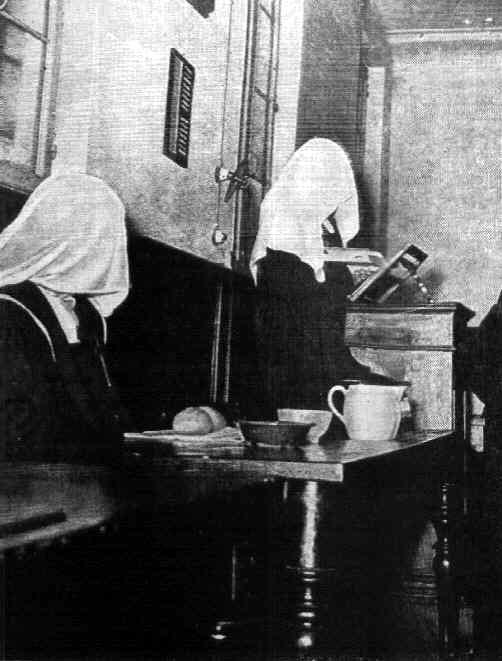By Plinio Corrêa de Oliveira
One of the most deplorable effects of the naturalistic, egalitarian and sensual neopaganism of our time is to degrade old age by “adorning” it with the appearances of youth and to “enhance” women’s looks by inducing them to display manners and an air of independence proper to man.
Here we three very modern ladies who have reached… a very mature age. On the whole, they show something masculine, sturdiness and a habit of self-guidance, imposing their own will, asserting themselves loudly in public, showing a noisy and triumphant joy that somehow resembles full-fledged self-made men who made good deals and like to show off … the more the better.
 Besides the masculine air one also sees the “Bonnie and Clyde” type. Whereas it is well for old age to keep a certain semblance of gravity even during leisure, these ladies laugh, eat and amuse themselves with the garrulousness of young girls. The striking patterns of their dresses and especially the festive extravagance of their hats accentuate this impression. The center figure wears in her head an elaborate and heterogeneous set of flowers and ribbons, all in light tones. The person on the left adorns her hair with a fanciful fountain of plumes ready to move at the slightest wind or nod of the head.
Besides the masculine air one also sees the “Bonnie and Clyde” type. Whereas it is well for old age to keep a certain semblance of gravity even during leisure, these ladies laugh, eat and amuse themselves with the garrulousness of young girls. The striking patterns of their dresses and especially the festive extravagance of their hats accentuate this impression. The center figure wears in her head an elaborate and heterogeneous set of flowers and ribbons, all in light tones. The person on the left adorns her hair with a fanciful fountain of plumes ready to move at the slightest wind or nod of the head.
On the whole everything in this picture that can be called typically modern tends to strip old age of its true attractions and to cover it with false attractions.
In contrast, the old folks of bygone days inspired so much confidence and respect. They did not conceal their physical decrepitude nor were ashamed of it for they knew that through the exteriorities of organic decay there shone the moral apogee of a soul that arrived at the fullness of its values.
Does anyone feel inclined to help the self-sufficient “girls” in our picture? Who can imagine receiving from them an advice full of seriousness, balance and serene elevation of soul?
Oh, how in each family the grandfather and grandmother of old were affable, solicitous and wise counselors who had no other pleasures but those of the home, nor any concern other than meditating on life and preparing for death!
 Old age is par excellence the suitable time to meditate on life, its vanities and illusions, and to prepare oneself for death. The Church commends it to all her children. Accordingly, She forms souls in such a way that youth should not have airs of light-hearted and easygoing exuberance but rather shine forth with virtues that normally attain their apex in old age.
Old age is par excellence the suitable time to meditate on life, its vanities and illusions, and to prepare oneself for death. The Church commends it to all her children. Accordingly, She forms souls in such a way that youth should not have airs of light-hearted and easygoing exuberance but rather shine forth with virtues that normally attain their apex in old age.
 An extreme and therefore sublime example of what the Church accomplishes in this respect is the recollection, austerity and immeasurable elevation of views to which their Rule invites Carmelites, even younger ones.
An extreme and therefore sublime example of what the Church accomplishes in this respect is the recollection, austerity and immeasurable elevation of views to which their Rule invites Carmelites, even younger ones.
Our picture presents a partial aspect of a Carmel refectory (on Via Borgo Vado, Rome). The nuns have their faces covered by a veil due to the presence of the photographer. They are about to start a meal. The reader is in the pulpit to entertain the community with a pious book.
Ambience Customs & Civilization No. 95 – November 1958









